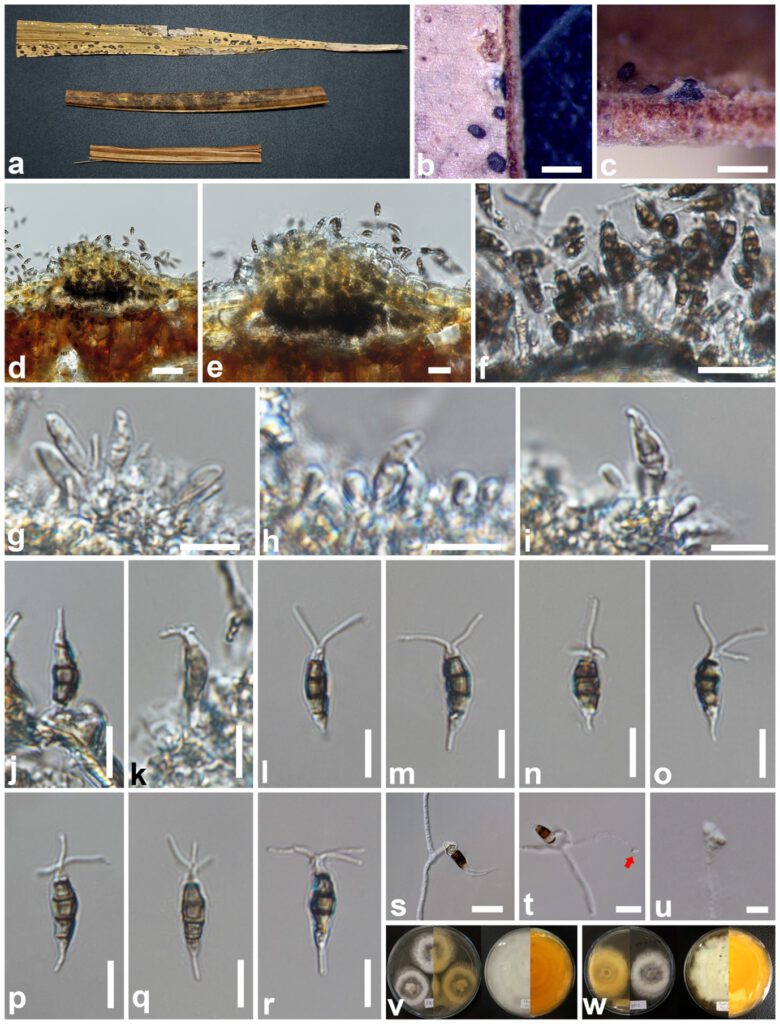Neopestalotiopsis elaeidis Konta & K.D. Hyde, in Konta, Tibpromma, Karunarathna, Samarakoon, Steven, Mapook, Boonmee, Senwanna, Balasuriya, Eungwanichayapant & Hyde, Mycosphere 14(1): 123 (2023)
Index Fungorum number:IF 559678; MycoBank number: MB 559678; Facesoffungi number: FoF 10824;
Etymology – Refers to the host genus Elaeis.
Holotype – MFLU 15–1466.
Saprobic on dead leaves of Elaeis guineensis. Sexual morph: Undetermined. Asexual morph: Conidiomata 105–140 × 180–245 µm (x̅ = 120 × 215 µm, n = 10), acervuli, subglobose to lenticular, visible as black spot, or black dome-shape, raised, solitary to gregarious, uniloculate. Conidiomata walls 7–10 µm (x̅ = 9 µm, n = 20), thick-walled, comprising several cell layers of dark brown, pseudoparenchymatous cells of textura angularis. Conidiophores reduced to conidiogenous cells. Conidiogenous cells enteroblastic, discrete, simple, short, filiform. Conidia 11–20 × 3–7 µm (x̅ = 16 × 5.5 µm, n = 20), fusiform to ellipsoid, straight to slightly curved, 4-septate; basal cell conic, hyaline, thin and smooth-walled, 2.42–4.22 µm long (x̅ = 3.25 µm), brown, verruculose; second cell from base brown, 2.5–4.37 µm (x̅ = 3.52 µm), third cell brown, 2.84–4.15 µm (x̅ = 3.5 µm), fourth cell darker brown, 2.36–4.94 µm (x̅ = 3.8 µm), apical cell 2.32–4.17 µm (x̅ = 3.17 µm), hyaline, cylindric to subcylindric; apical appendages 9–17 µm long (x̅ = 12 µm), (mostly 3), basal appendage present (1 or rarely absent), filiform 2–5.5 µm (x̅ = 3.5 µm). Appressoria irregular, hyaline, rough-walled, 3.42–4.64 × 3.39–4.64 μm (x̅ = 3.95 × 4.02 μm).
Culture characteristics – Colonies on MEA. Colonies from above; white, circular, mycelia medium dense, flat or raised, with filiform margin, fluffy, with black spot of fruiting bodies. Colonies from below, same as above.
Material examined – Thailand, Songkhla Province, on dead leaves of Elaeis guineensis (Arecaceae), 16 June 2015, Benjarong Thongbai, SK01d (MFLU 15-1466, holotype), ex-type living culture, MFLUCC 15-0735; Chiang Mai Province, on dead leaves of unidentified palm (Arecaceae), 19 July 2015, Putarak Chomnunti, Fg01c (MFLU 15-2334), living culture, MFLUCC 15-0801.
GenBank numbers – MFLUCC 15-0735: LSU = ON650696; ITS = ON650690; SSU = ON650698, RPB2 = ON734016, TEF1 = ON734012; MFLUCC 15-0801: LSU = ON650695; ITS = ON650689; SSU = ON650697; TEF1 = ON734011.
Notes – In the phylogenetic analyses, Neopestalotiopsis isolates (MFLUCC 15-0801, MFLUCC 15-0735) clustered basal to N. pernambucana RV01, N. surinamensis CBS 450.74, N. acrostichi MFLUCC 17-1754, N. protearum CBS 114178 and N. guajavae FMB0026 (Fig. 8). Taxonomic identification of Neopestalotiopsis is difficult because of the cryptic evolutionary history of the genus. Therefore, we were unable to compare the morphological characteristics of
closely related taxa in the phylogenetic tree (Fig. 8) as they are very similar. In the BLASTn NCBI GenBank database search of LSU, ITS, SSU, RPB2 and TUB sequences, Neopestalotiopsis elaeidis isolates (MFLUCC 15-0735, and MFLUCC 15-0801) are most similar; to N. piceana (CBS 394.48) with 100% (LSU); to N. eucalypticola (CBS 264.37) with 99.82% (ITS); to Pseudopestalotiopsis thailandica (MFLUCC 17-1724) (isolate MFLUCC 15-0735) and to N. petila (MFLUCC 17-1737) (isolate MFLUCC 15-0801) with 100%, and 100% (SSU); to N. protearum (CBS 114178) with 99.45%, and 99.82% (RPB2); and to Seiridium marginatum (SEI) (isolate MFLUCC 15-0801) and to Pestalotiopsis ellipsospora (MFLUCC12-0283) (isolate MFLUCC 15-0801) with 93.79%, and 99.47% (TUB) similarity. Based on our investigation, the phylogenetic data revealed our collection as a novel species of Neopestalotiopsis. Thus, we introduce our collection as a new species from dead leaves of Elaeis guineensis and leaves of unidentified palm (Arecaceae). Appressoria in Neopestalotiopsis elaeidis were also observed and presented. Neopestalotiopsis elaeidis sp. nov. could be used for further studies in the investigation of why saprobe life mode on the dead leaves of palms is able to produce appressoria (specialized cells of many fungal plant pathogens) as oil palm is an economically important plant, worldwide.

Fig. XX Neopestalotiopsis elaeidis (MFLU 15–1466, holotype, MFLU 15-2334, isotype). a The Appearance of conidiomata on host substrate. b Close up of conidioma from top view. c Close up of conidioma from side view. d, e Vertical section of conidioma. f–k Conidiogenous cells with conidia. l–r Conidia. s Germinated conidium of MFLUCC 15-073. t Germinated conidium with appressorium pointed by red arrow of MFLUCC 15-0801. u Appressorium. v Colonies on MEA of MFLUCC 15-0735. w Colonies on MEA of MFLUCC 15-0801. Scale bars b, c = 200 μm, d = 50 μm, e, f, s, t = 20 μm, g–r = 10 μm, u = 3 μm.
